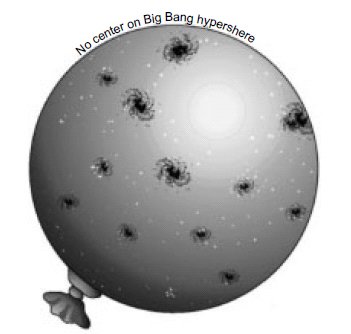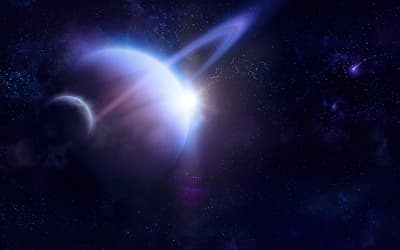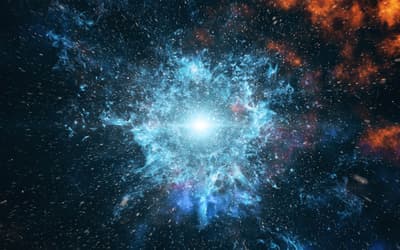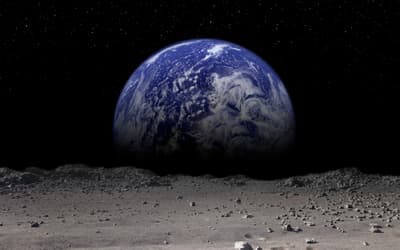The views expressed in this paper are those of the writer(s) and are not necessarily those of the ARJ Editor or Answers in Genesis.
Abstract
“Thus saith the LORD, thy redeemer, and he that formed thee from the womb, I am the LORD that maketh all things; that stretcheth forth the heavens alone; that spreadeth abroad the earth by myself” (Isaiah 44:24 KJV). Scriptural texts like this have been used by biblical creationists to justify God creating an expanding cosmos. Aside from arguing that the Scriptures do indeed describe cosmological expansion, I contend that expansion of space is of itself not tenable as a mechanism for the expansion of the universe, as often cited with the famous rubber balloon analogy. Relativity theory, properly applied, tells us that detection of the expansion of space by any local measurement is not possible. And if the æther is the substance of the universe that has supposedly expanded, with the galaxies embedded therein, then it is fundamentally undetectable. This assigns cosmology firmly to the realms of philosophy and metaphysics.
Introduction
In my own developments in cosmology you can easily find statements I have made where I describe the expansion of space as the mechanism for an expanding universe. I developed a creationist cosmology (Hartnett 2010) based on that of the late Professor Moshe Carmeli’s Cosmological General Relativity theory. In that cosmology, like in the standard big bang model, the universe is expanding, but the galaxies are fixed in space and being dragged apart by the expansion of the fabric of space. They are not considered to be moving through space at all.

Fig. 1. Rubber balloon analogy for the expansion of the universe. Galaxies are fixed in space, on the rubber material of the balloon, and when the balloon is blown up the galaxies all move away from each other as space is stretched out. It illustrates how there need be no center and no edge. This universe is then finite but unbounded. More correctly the analogy should be buttons glued onto the balloon as the galaxies do not stretch out or expand themselves as the balloon is blown up.
But is that idea 1) justifiable from Scripture and/ or 2) justifiable from observational evidence of all the different lines available to us? I found that the notion of “cosmological expansion”—the stretching out of the fabric of space—like the oft-quoted analogy of the expanding rubber balloon, by more than a factor of a thousand fold, cannot be derived from, nor justified by, the biblical texts (Hartnett 2011a) (fig. 1).
I once reviewed the available secular scientific literature and found that the notion of the expanding universe could not be clearly justified one way or the other (Hartnett 2011b, 2011c).
Taken together, the various lines of observational evidence were found to be equivocal, on the question of whether the universe is expanding or not. Those lines of evidence were not on trying to distinguish the mechanism, or whether it results from expansion of space or something like the motion of galaxies outward from us into an existing space.
The latter, a Doppler motion of galaxies through space, is the initial understanding that astronomers had in Edwin Hubble’s day, but modern cosmologists have since insisted that that is wrong, and that the galaxies are not moving through space, but being dragged apart by the expansion of space itself.
There are two questions that need answering: Is the universe expanding? And, if so, is it by the mechanism of the expansion of space (EoS)? The latter has been promoted as the mechanism whereby the universe has expanded over the past 13.8 billion years since the alleged big bang. But how valid is the hypothesis?
In this discussion we need to define a few terms. They are “space,” “the vacuum,” “the æther” and “cosmic substratum.” There are other terms that are sometimes used but these are all that is necessary here. However since some of these terms are used interchangeably for this discussion we need to be quite clear what each means in the following. (Note: these terms may be used differently by other authors and for any precise comparison those differences must be taken into account.)
Space
Space is defined by three orthogonal dimensions, length, breadth, and width. In our ordinary experience we only conceive of these as distances in a local measurement. Often the word “space” is used in reference to the cosmos, the volume which is occupied by stars and galaxies. Strictly speaking “space” is a geometrical concept, and in this sense, “space” here means the volume defined by its dimensions. Most importantly, space only has meaning where it defines the presence of its occupying substance. I contend therefore that absolutely empty space does not exist in the physical universe. This is a position that Einstein held in 1920 (Einstein 1922).
Is space a substance? Sometimes authors have use the expression “fabric of space” referring to it as some substance, as I have myself. In this article my meaning of “space” is strictly geometry only and does not of comprise any substance itself. Interestingly, the concept still remains a mystery to many physicists (Chromie 2012).
The Vacuum
If we take a volume occupied by the space represented by the dimensions of certain length, breadth, and width and empty it of all matter (solid, liquid, and gas) then what remains is a vacuum. But from physics, we know that vacuum is not the absence of all things, including all energy. Even if we could pump out all atoms from a volume of space (in a vacuum vessel for example) and somehow shield that space from the thermal radiation (heat) coming from the walls of the vessel, it would still contain energy. This is called vacuum energy. And even if you cooled the walls of the vacuum chamber to absolute zero, i.e. −273.15°C, there would still be some energy left in the vacuum, called zero point energy (ZPE). This results from the facts of the Heisenberg uncertainty principle and that subatomic particles exist as quantized units.
This entity is often called the quantum vacuum. Vacuum energy comes from the spontaneous emission of virtual particle/anti-particle pairs that appear momentarily from small quanta of energy from the vacuum, sort of a quantum foamy stuff, and then these particle pairs self-annihilate releasing the same quanta of energy back into the vacuum. Its energy density is non-zero, in fact, if you estimate it from electron/anti-electron pairs filling a volume on the scale of their Compton wavelength you get an energy density about 48 magnitudes higher than the estimated average mass density of the universe. From this it follows that the matter content of the universe is only a tiny fraction of the total energy, when compared to the vacuum energy. The particular choice of the wavelength one uses for the cut-off energy in the calculation of its energy density has led to a figure as high as 10120 times the average mass density of the universe.
The Æther
The æther or the luminiferous æther is the once postulated medium through which light waves were thought to travel. It was likened to a substance that allows light waves to travel by direct analogy to water waves through an ocean, or, sound waves through the atmosphere.
However, the need for the æther was eliminated,1 in 1905, when Einstein showed that by properly considering time as a dimension in an equivalent way to, or, on equal footing with, the three spatial dimensions, and that all inertial observers,2 regardless of their motion, would measure the same speed for light in any local experiment. This broke time out of its position as some absolute concept and meant that the speed of light is independent of the observer’s speed. This also meant no experiment could detect one’s motion relative to the hypothetical æther. Neither could any experiment detect the presence of the æther.
Prior to Einstein’s and Minkowski’s development of Special Relativity (SR) theory, Lorentz had developed his own theory which gave to the æther mechanical properties such that measuring rods contracted in length in the direction of their motion and clocks slowed in “local” time with respect to the observer at rest in the æther. These effects worked to defeat the detection of the æther itself. His theory was developed in response to the negative results of the Michelson’s æther drift experiments—the now-famous Michelson-Morley experiments.
Einstein incorporated Lorentz’s transforms into SR making it mathematically identical to the Lorentz theory. The difference being that the latter assumed an undetectable æther whereas SR transformed our notion of not just space but also of time away from them being absolute concepts.
In Einstein’s theory the immutability of the spacetime interval that links events and the two-way speed of light (c) as measured by any inertial observer are absolutes. This meant that the physics (the laws that govern the universe) would be determined to be the same by any observer regardless of his motion. No æther was needed.
Cosmic Substratum
The cosmic substratum (Chodorowski 2007) is an idealized, smooth cosmic fluid which is evenly spread throughout space and thus possesses a constant density. Its mass is equal to the mass of the constituents of the universe (Clark 1997). The average density of the universe based on the smoothed out matter density is about 4% of what is called “critical density,” which works out to be approximately 10-28 kg/m3, equivalent to roughly a proton per cubic meter.
Are These Labels for the Same Thing?
By contrast the quantum vacuum has an energy density a least 48 orders of magnitude higher than that. But it depends on how you calculate it. If you assume that an electron/positron pair of virtual particles are the heaviest of all virtual particles, that momentarily pop in and out of existence in the vacuum, and you find a pair every Compton wavelength apart, then you arrive at a number about 1020 kg/m3. That is extremely dense indeed. Some have suggested that this medium exhibits a structure that impedes the progress of photons through the vacuum, limiting their speed to what we measure, the finite speed of light, c (Urban et al. 2013).
Can the quantum vacuum act like the luminiferous æther? If so it would add some sort of absolute frame of reference to the universe, yet still relativity would apply, since we can’t detect its motion, nor ours with respect to it. That would be like in the Lorentz theory. Yet if the quantum vacuum and the æther are in fact synonymous then it is not the same æther as in the Lorentz theory, which was not detectable by any local experiment. The quantum vacuum is detectable by such effects as the Lamb shift, a shift in the energy levels of an atom, resulting from the polarization of the vacuum around it.
Though Einstein vanquished the æther in 1905, did he reintroduce it again in 1916 with his general relativity (GR) theory?3 It seems in that theory spacetime became curved with the introduction of accelerations and gravity, via the equivalence principle, and thus its curvature in the new physics determined the motion of the particles in the spacetime. Einstein borrowed from Riemannian geometry, and developed a general theory, which deals with the tangent spaces around an infinitesimal point in the curved spacetime.
This new theory has been very successful indeed in the solar system and local tests. For something to be curved it is argued it needs to be curved into something—a hyper-dimension. Does that mean spacetime has reintroduced space as a substance, an æther, with mechanical properties like Lorentz envisaged? If so, it cannot be the quantum vacuum, because the physics of GR only involves the matter and energy of the constituents of the universe, the cosmic substratum.
In the Beginning
I once held to the notion that a geometrical empty space was possible. But if truly nothing occupies that space (and I don’t mean, notwithstanding ZPE in the vacuum, but truly nothing) then how can space exist?
Within the vacuum we refer to as “outer space,” matter and energy reside. It makes up everything we know of in the universe, galaxies, stars, and planets and all the stuff in between. Since vacuum always contains energy is there any meaning in the concept of empty space? I think not.
You might ask: where did the vacuum come from before the matter was created? But was vacuum ever created devoid of any energy at all? Again I think not.
Starting with the Creator: (Genesis 1:1)
בְּרֵאשִׁית בָּרָא אֱלֹהִים אֵת הַשָּׁמַיִם וְאֵת הָאָרֶץ׃
In the beginning God created the heaven and the earth.
The Hebrew word translated “heaven” is שָׁמַיִם. (shamayim), which my lexicon translates as “the higher æther where the celestial bodies revolve.” 4 This has been interpreted as the creation of space, which God then filled with the earth and additional matter and energy from which He created everything in the universe. But since vacuum is never empty, I suggest it is the vacuum that He created at this initial moment, with all the existing vacuum energy, and then He filled that with the planet earth and other heavenly bodies over the course of Days 1 through 4 of Creation Week. Here I am arguing against some absolute concept of empty geometry only.
As defined above, the quantum vacuum contains an enormous amount of energy. But it does not come into the spacetime geometrical representation which Einstein so successfully introduced to describe the motion of heavenly bodies. Yet the vacuum seems to be extremely dense in the sense of its energy density due to virtual particles. Could this be the reason that the universe is spatially Euclidean?
Once the vacuum had been created (Genesis 1:1) God said, Let there be light: and there was light. And God saw the light, that it was good: and God divided the light from the darkness. (Genesis 1:3, 4; KJV)
The quantum vacuum impedes the progress of photons through space to the speed, c, and hence it introduces the first “clock” and the forward arrow of time. Empty space would have meant unimpeded photons with infinite speed. By inference then there never existed a time of empty space.
Expansion of Space
With the standard Friedmann-Lemaître (FL) cosmology of the universe there are those who claim the space occupied by the cosmos, is expanding—i.e. the galaxies are fixed in space as space expands. This idea of EoS is very contrary to the spirit of GR upon which the FL cosmologies are built. It also results in concepts that are apparently in violation of SR too, specifically the superluminal expansion of distant galaxies and the acausality of the particle horizon.5
Chodorowski argues that EoS is wrong, the EoS is a geometric effect, so space itself is absolute. Then, though abolished in SR, in cosmology absolute space reenters triumphally the cosmic arena, endowed with an additional attribute: expansion. . . . it suggests the existence of a new mysterious force. If so, one can expect non-standard effects also on small scales. (Chodorowski 2007)
For example, it has been speculated that locally particles might be dragged along by the EoS. This has been shown not to be the case (Barnes et al. 2006, p. 382; Davis, Lineweaver, and Webb 2003, p. 358; Whiting 2004, p. 174). It was also believed that the
. . . . wavelengths of laboratory photons should change roughly by the factor 1 + H0 τexp, where τexp is the duration of a given experiment and H0 is the Hubble constant . . . This is also wrong. (Lieu and Gregory 2006 quoted in Chodorowski 2007)
This is the idea that one could do a local experiment to detect cosmological expansion of space. But it is not possible. This then makes the idea of EoS problematic.
I reviewed evidences (Hartnett 2011b; 2011c) for and against the notion of expansion of space and at that time I considered it the mechanism for the expansion of the universe. But when weighed together I found the conclusion equivocal. However, this is the current belief system promoted by the majority of cosmologists whereby the universe has grown in size by a linear factor of at least 1030 since the big bang origin. So this must be an important concept. The factor here includes expansion from the putative inflation period (Hartnett 2014a).
The main line of support comes from GR—the fact that cosmological redshifts of distant galaxies are a mathematical prediction of GR itself. The idea is that if one sent out a light signal to a distant galactic source in an expanding universe, then that light signal would take longer on the return inbound path than on the outbound path. Because the inbound time interval is greater than the outbound time interval it is concluded that wavelengths of the light must be stretched to compensate. This was included in my review (Hartnett 2011b).
The idea is appealing as a gedanken or thought experiment. But, like other examples in relativity, this can be shown to be not as you might imagine. Chodorowski (2007) shows concisely that no difference would be detected. The reason is that the necessary time-dilation effect has to be taken into account and hence one could not detect expansion of space.
This result then is consistent with SR and it overcomes the conceptual problems of the superluminal expansion of distant galaxies and the acausality of the particle horizon. With the correct understanding, that particles move in the cosmic substratum, i.e. with space, because space simply enables particles to exist, then these problems vanish. The term “with space” does not mean space stretches but as galaxies supposedly move apart with the cosmic substratum, by definition, they define the space they exist in.
There is no argument against the validity of GR, but that a more appropriate choice of coordinates needs to be made and in doing so these problems are eliminated. The primary argument for EoS cannot be made. It would be impossible to detect any EoS by any local experiment. This then puts the notion of expansion, now even redefined by the cosmic substratum (in terms of the real fluid or the matter content of the universe) into the realm of philosophy, not experimental testable science that could be done in a laboratory in the solar system.
In this sense, expanding space is as real as the “æther” (with any state of motion itself) that Einstein vanquished over 100 years ago, which was not locally detectable via the Michelson-Morley experiment at that time, nor since.
Summary
Has the universe expanded over time? The argument once was that to achieve cosmological expansion, any two particles are fixed in the geometry of space and somehow vacuum is created between them. The particles are not moving through space but space is being created between them and hence to a distant observer their relative positions appear, over time, to increase. But an observer would measure nothing locally. One required cosmic distances to observe the changes.
The standard explanation is that galaxies don’t expand with the space they occupy expanding around them, due to their gravity, so we should not expect to see anything locally. This is the notion of EoS on the scale of the universe, but not observable on the local scale where only SR applies. The hypothesis is that in SR particles move through space, but cosmologically, clusters of galaxies are fixed in the space.
I argue that this hypothesis is invalid and that no local or global experiment could detect expansion of space, or even of the cosmic substratum. Relativity simply will not allow that. And that puts cosmology firmly into the realm of metaphysics.
Often, the rubber balloon analogy is used—galaxies stuck on the surface as the balloon is blown up—which illustrates space expanding and the galaxies being pushed apart from each other (and also that there is no centre, no special place uniquely for us in the universe) (see fig. 1).
Nowadays, the expanding big bang universe is considered to be established dogma, but it has its own problems. The biggest is the problem of kinetic energy of the galaxies driven apart by massless space. Do they have kinetic energy? Those with the EoS “surface of the balloon” analogy cannot have kinetic energy because they are not moving through space, but if they move with the cosmic substratum they do. In the case of the former, the universe has been called the “ultimate free lunch” (Stenger 1990), but really it just adds more questions.
Conclusion
From a biblical perspective it is worth asking the question: Does the Bible really describe expansion of the universe anyway? (Hartnett 2014b). Numerous verses have been used by creationists6 (e.g. Psalm 104:2; Isaiah 40:22, 42:5, 44:24; Job 9:8, 37:18), myself included, to say that the universe has undergone cosmological expansion, as part of God’s creation. But it would seem that it is pure eisegesis, and not good exegesis.
With the above discussion in mind, the idea that the biblical text could at all allude to expansion of space, the balloon analogy for example, now seems quite preposterous. Those Scriptures quite plainly refer to the fact that God created the heavens, and in doing so He created the starry host that occupies the interstellar space. The metaphors of putting up a tent, curtain, or canopy are often used.
The galaxies and stars determine the space they occupy. The only possibility for an expanding cosmic fluid (which Scripture does not mention) is the idea of the cosmic substratum, which is not space. Space is determined by the presence of its constituents. But relativity theory, when properly understood, tells us that the æther, some sort of absolute spatial entity with kinematical properties (quite separate from the matter content of the universe), if it exists, is completely undetectable. As such the notion of expansion of the fabric of space is a Dark Science.
References
Barnes L. A., M. J. Francis, J. B. James, and G. F. Lewis. 2006. Joining the Hubble flow: Implications for expanding space. Monthly Notices of the Royal Astronomical Society 373, no. 1: 382–390.
Chodorowski, M. J. 2007. A direct consequence of the expansion of space? Monthly Notices for the Royal Astronomical Society 378, no. 1: 239–244.
Chromie, E. 2012. Fabric of space. http://www.salem-news.com/articles/july242012/space-fabric-ec.php.
Clark, S. 1997. Towards the edge of the universe. Hoboken, New Jersey: Wiley.
Davis, T. M., C. H. Lineweaver, and J. K. Webb. 2003. Solutions to the tethered galaxy problem in an expanding universe and the observation of receding blueshifted objects. American Journal of Physics 71, no. 4: 358–364.
Einstein, A. 1922. Ether and the theory of relativity. In Sidelights on relativity, ed. A. Einstein, pp. 18, 19. Toronto, Canada: General Publishing Company.
Hartnett, J. G. 2010. Starlight time and the new physics. 2nd ed. Atlanta, Georgia: Creation Book Publishers.
Hartnett, J. G. 2011a. Does the Bible really describe expansion of the universe? Journal of Creation 25, no. 2: 125–127.
Hartnett, J. G. 2011b. Does observational evidence indicate the universe is expanding?—part 1: the case for time dilation. Journal of Creation 25, no. 3: 109–114.
Hartnett, J. G. 2011c. Does observational evidence indicate the universe is expanding?—part 2: the case against expansion. Journal of Creation 25, no. 3: 115–120.
Hartnett, J. G. 2014a. The authors of the claimed biggest astrophysics discovery of the century admit they may have been wrong. http://johnhartnett.org/2014/07/03/the-authors-of-the-claimed-biggest-astrophysics-discovery-of-the-century-admit-they-may-have-been-wrong/.
Hartnett, J. G. 2014b. Does the Bible really describe expansion of the universe? http://johnhartnett.org/2014/04/14/does-the-bible-really-describe-expansion-of-the-universe/.
Hartnett, J. G. 2014c. The big bang is not a Reason to Believe! http://johnhartnett.org/2014/05/20/the-big-bang-is-not-a-reason- to-believe/.
Lieu, R., and D. A. Gregory. 2006. The exclusion of WMAP’s Hubble constant by laser interferometry. preprint (astroph/ 0605611, ver. 1 compare with later versions 2 and 3). http://arxiv.org/pdf/astro-ph/0605611v1.pdf.
Stenger, V. J. 1990. The universe: The ultimate free lunch. European Journal of Physics 11, no. 4: 236–243.
Urban, M., F. Couchot, X. Sarazin, and A. Djannati-Atai. 2013. The quantum vacuum as the origin of the speed of light. The European Physical Journal D 67, no. 3: 58–63.
Whiting A. B. 2004. The expansion of space: Free-particle motion and the cosmological redshift. The Observatory 124: 174–189.









